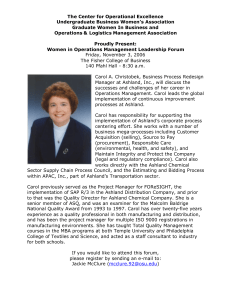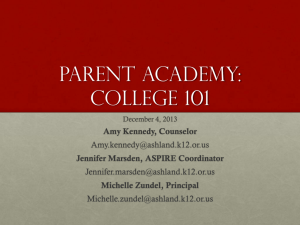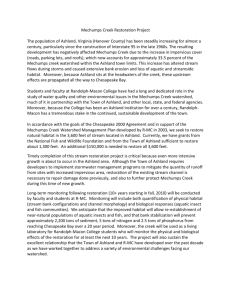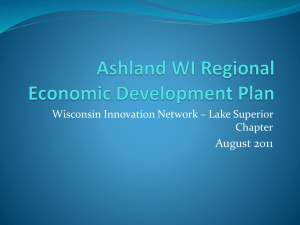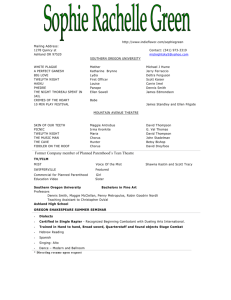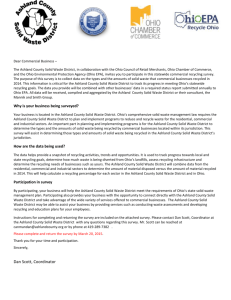164 City of Ashland Fire and Rescue
advertisement
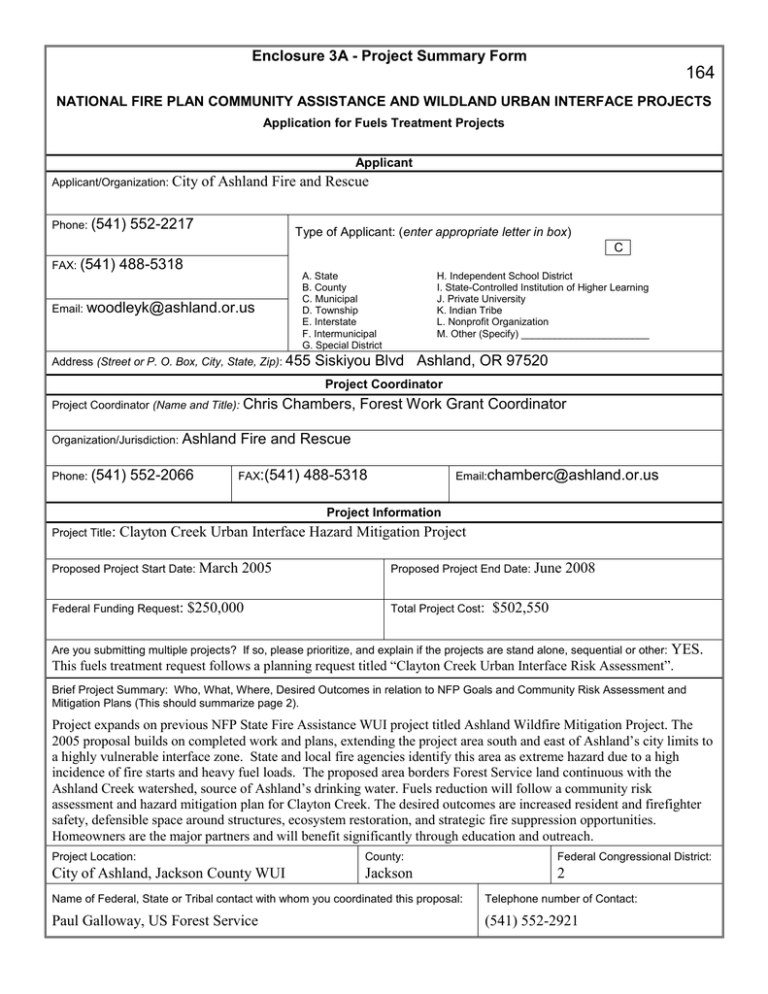
Enclosure 3A - Project Summary Form 164 NATIONAL FIRE PLAN COMMUNITY ASSISTANCE AND WILDLAND URBAN INTERFACE PROJECTS Application for Fuels Treatment Projects Applicant Applicant/Organization: City Phone: (541) of Ashland Fire and Rescue 552-2217 Type of Applicant: (enter appropriate letter in box) C FAX: (541) 488-5318 A. State B. County C. Municipal D. Township E. Interstate F. Intermunicipal G. Special District Email: woodleyk@ashland.or.us Address (Street or P. O. Box, City, State, Zip): 455 H. Independent School District I. State-Controlled Institution of Higher Learning J. Private University K. Indian Tribe L. Nonprofit Organization M. Other (Specify) _______________________ Siskiyou Blvd Ashland, OR 97520 Project Coordinator Project Coordinator (Name and Title): Chris Chambers, Forest Work Grant Coordinator Organization/Jurisdiction: Ashland Fire and Rescue Phone: (541) FAX:(541) 552-2066 488-5318 Email:chamberc@ashland.or.us Project Information Project Title: Clayton Creek Urban Interface Hazard Mitigation Project Proposed Project Start Date: March Federal Funding Request: 2005 $250,000 Proposed Project End Date: June Total Project Cost: 2008 $502,550 Are you submitting multiple projects? If so, please prioritize, and explain if the projects are stand alone, sequential or other: YES. This fuels treatment request follows a planning request titled “Clayton Creek Urban Interface Risk Assessment”. Brief Project Summary: Who, What, Where, Desired Outcomes in relation to NFP Goals and Community Risk Assessment and Mitigation Plans (This should summarize page 2). Project expands on previous NFP State Fire Assistance WUI project titled Ashland Wildfire Mitigation Project. The 2005 proposal builds on completed work and plans, extending the project area south and east of Ashland’s city limits to a highly vulnerable interface zone. State and local fire agencies identify this area as extreme hazard due to a high incidence of fire starts and heavy fuel loads. The proposed area borders Forest Service land continuous with the Ashland Creek watershed, source of Ashland’s drinking water. Fuels reduction will follow a community risk assessment and hazard mitigation plan for Clayton Creek. The desired outcomes are increased resident and firefighter safety, defensible space around structures, ecosystem restoration, and strategic fire suppression opportunities. Homeowners are the major partners and will benefit significantly through education and outreach. Project Location: County: Federal Congressional District: City of Ashland, Jackson County WUI Jackson 2 Name of Federal, State or Tribal contact with whom you coordinated this proposal: Telephone number of Contact: Paul Galloway, US Forest Service (541) 552-2921 Enclosure 3A (Page 1 of 3) - Project Narrative Description Applications for funding must include a narrative response that describes the proposal. Please do not submit responses longer than one page, single space, 12-pitch font. Describe project including, but not limited to: project location (e.g., Watershed, Address neighboring community) these items as applicable: anticipated outcomes project relationship to the community risk assessment and mitigation plan amount or extent of actions (acres, number of homes, etc.) community partners and their project timeline and matching or contributed funds role(s) proponent’s ability to complete project For this project, explain the level of cooperation, coordination or strategic planning, through a “Local Coordination Group.” If you haven’t worked with a local coordination group, why not? The proposed project is located in the Clayton Creek drainage, TRS 391E S23,24,25,26,36 and TRS 402ES6. Steep slopes, extremely flammable vegetation, and a high concentration of fire starts characterize the project area. These factors, combined with approximately 150 structures and 2500 acres of private land placed Clayton Creek in the State of Oregon’s Urban Interface Fire Protection Act (SB360) extreme danger category. The outcome of fuels reduction work in this area will be to create defensible space zones around structures, educate homeowners about wildfire safety, thin roadsides for safe ingress/egress, and create tactical suppression opportunities. Partners will be private landowners. This project will follow the planning effort titled “Clayton Creek Urban Interface Risk Assessment”. Submitted concurrently with this proposal, the risk assessment and planning will outline high priority zone where funds create the best opportunity for fire suppression and community safety. The fuels reduction project will begin in the fall of 2005 and take approximately 2 to 3 years to exhaust funds. Ashland Fire and Rescue has been the recipient of 4 Oregon Department of Forestry State Fire Assistance Grants from the Fire Plan. In cooperation with the ODF, over 600 acres are completed or slated for completion this year in Ashland’s WUI. A Forest Work Grant Coordinator position has been funded through Jackson County Title III money since 2002. Responsibilities of this employee include implementation of fuel reduction plans, landowner outreach, payment coordination, and follow-up inspections. The Ashland wildfire coordination group has been meeting quarterly since 2001. Members of the group include: Ashland Ranger District (USFS), Oregon Department of Forestry, City of Ashland, Ashland Watershed Stewardship Alliance, and the Ashland Forest Lands Commission. Wildfire fuels reduction planning and implementation plans are shared to coordinate fuel management projects across ownerships. Past coordination has lead to utilization of BLM contractors through the ODF for private land projects, prescribed burning across property lines, sharing of GIS data, and joint efforts in a landscape fire management planning process. Coordination will increase as landscape management efforts at all levels are implemented. A two-county local coordination group (LCG) has been approved through Jackson and Josephine county. In 2002-2003, Ashland’s wildfire grant coordinator was a member of a Jackson County wildfire coordination group leading to formation of the current two county LCG. Ashland will be working closely with the twocounty LCG in the future. Enclosure 3A (Page 2 of 3) - Project Evaluation Criteria Applications for funding must include narrative responses that address the following three criteria. Be sure you address every one briefly, yet thoroughly. Limit your responses to the area provided. 1. Reducing Hazardous Fuels (50 points) A. Describe the community infrastructure that will be protected. B. Explain how the proposal reduces fire behavior in high hazard areas by describing the fuels to be disposed or removed, and the techniques and timing of the treatments. C. How will the proposed treatments be maintained in future years? D. How will you use multi-party monitoring to improve this and future projects? Response: The Clayton Creek community consists of over 150 structures and three county roads. Federal land and private industrial timberland abut the project area. The western boundary of the Clayton Creek project area is less than one linear mile from the Ashland Creek watershed, source of Ashland’s drinking water and designated Late Successional Reserve and Research Natural Area. Vegetation types in the project area are dense whiteleaf manzanita, suppressed mixed conifer stands, and oak woodlands. Vertical and horizontal fuel continuity is high across the project area. Work will focus on removal of ladder fuel and breaking up horizontal fuel continuity. Fuel treatments in the area will consist of piling and burning, chipping, and limited lop and scatter treatments. Use of “Slashbuster” type machines will be considered on a site by site basis. Treatments will take place in accord with fire season regulations. Private owners will maintain treatments in future years. Maintenance costs will be far lower than initial treatment costs, making it easier for owners to hire help or perform their own maintenance. During the initial outreach and subsequent implementation, landowners will receive education and information regarding maintenance. Prescribed fire will have limited application in the project area due to the presence of structures and conflicting ownership objectives. Enclosure 3A (Page 3 of 3) - Project Evaluation Criteria 2. Increasing Local Capacity (25 points) A. How would the proposal improve or lead to the improvement of the local economy in terms of jobs and sustainable economic activity? B. How many jobs are expected to be created or retained and for how long? (Please distinguish between essentially year-round and seasonal jobs). C. What tools and skills will be gained or utilized as a result of this project? D. Will biomass be utilized; if so, in what manner and how much? Response: In conjunction with adjacent work on Federal land planned for 2005 through 2015, there is an excellent opportunity for local contractors to sustain jobs in this area. For the various contractors working in the Ashland interface zone, this will keep employees working as funding and volume of work associated with the private owners in Ashland’s interface decreases. An estimate of jobs is difficult because landowners may choose a contractor or do work themselves. Work is typically spread out among several contracting crews. There will also be opportunities to involve the local Job Council, Jackson County Community Justice, and Natural Resources Youth Corps crews. These crews are all community service crews focused on education an rehabilitation. A key educational outcome will be gained by the landowners. Through site visits and home evaluations the homeowners will learn how to develop and maintain a fire-safe home and defensible space zone. Research suggests that these are the most important factors leading to home survivability in a wildland fire. Landowners will also learn about local ecology, plant communities, and wildfire behavior. This information will be key for maintenance of treatments. Biomass will generally be unmerchantable brush and small trees. If landowners choose chipping as an alternative, the chips can be utilized as landscaping. If there are areas where commercial utilization is an option it will be pursued. The grant coordinator has experience identifying small-scale utilization projects as well as contacts for contractors experienced with utilization. Demonstrating Community and Intergovernmental Collaboration (25 Points) E. How will this project implement a community risk assessment and mitigation plan? Include name of plan, date it was prepared, and local contact to get a copy of the plan if requested. F. How has this treatment been coordinated with adjacent landowners and local/State/Tribal/Federal agencies? G. Identify the cooperators/partners involved in implementation of this project. H. Describe the extent of current local support for the project, including any cost-sharing agreements Response: The project will implement the community risk assessment and mitigation plan concurrently applied for in the 2005 funding cycle. The Clayton Creek planning project will be completed before any ground-disturbing activities have taken place. To date, fuel reduction awards and their associated NEPA requirements have not allowed work to begin before fire season of the award year. The planning timeline will work perfectly to start work after the fire season of 2005 ends. The plan will extend Ashland’s current plan using the same methodology and mapping technique. The current map and plan are available on the City’s web site: http://www.ashland.or.us/Files/Fire%20city%20Plan%202002.htm and http://www.ashland.or.us/Files/fire_map_sm.PDF Several calls have been received from residents of the project area regarding fuels reduction grant funding. The inquiries were turned away because this area is not yet included in a planning or grant area. Private owners will be the major partners in this project. A cost share agreement will be worked out with each owner prior to the start of work. The cost share grant portion will be based on steepness of the slope and vegetation density. Coordination with adjacent federal land will take place when the Forest Service makes final planning and implementation decisions in the Upper Bear Analysis Area. Through the local coordination group, communication channels exist in order to plan treatments across boundaries. Enclosure 3A - Project Work Form Tasks Time Frame Responsible Party Outreach to landowners, project planning. September 2005 through 2007 Ashland Fire and Rescue, Grant Coordinator. Fuels reduction project implementation November 2005 continuing through 2007 as fire season restrictions allow. Ashland Fire and Rescue, Grant Coordinator Photo monitoring, grant accounting and reimbursements. September 2005 ongoing to completion or December 2007. Ashland Fire and Rescue, Grant Coordinator and City Finance Department. GIS database and Suppression Opportunities Map Ongoing throughout project implementation. Grant Coordinator, GIS Analyst Enclosure 3D Project Budget Cost Category Description Federal Agency Personnel- Includes Coordinator, Finance, and GIS Support Sept. 2005-Sept2006 Oct. 2006-Sept2007 Subtotal City of Ashland $25,000 $25,000 $50,000 Jackson County Title III Private Landowners Total $40,000 $40,000 $80,000 $130,000 Fringe Benefits 2005-2006 2006-2007 Subtotal $13,000 $13,000 $26,000 $26,000 Travel Mileage expenses Subtotal $1000 $1000 $1,000 Equipment Digital Camera-Photo Monitoring Subtotal $400 $400 $400 Supplies Flagging $50 Subtotal $50 $50 Fuels Reduction 2005-2006 2006-2007 Subtotal $86,275 $86,275 $86,275 $86,275 $172,550 $172,550 $345,100 Subtotal Total Costs Project (Program) Income1 (using deductive alternative) 1 Program income is the gross revenue generated by a grant or cooperative agreement supported activity during the life of the grant. Program income can be made by recipients from fees charged for conference or workshop attendance, from rental fees earned from renting out real property or equipment acquired with grant or cooperative agreement funds, or from the sale of commodities or items developed under the grant or cooperative agreement. The use of Program Income during the project period may require prior approval by the granting agency. $502,550
